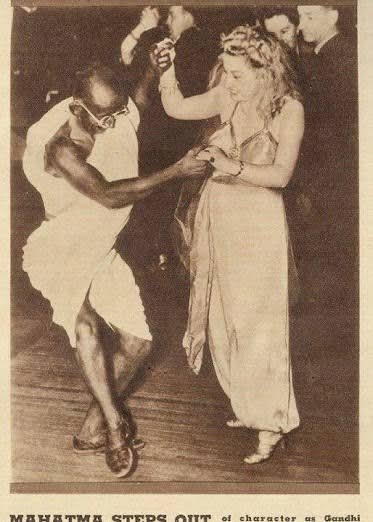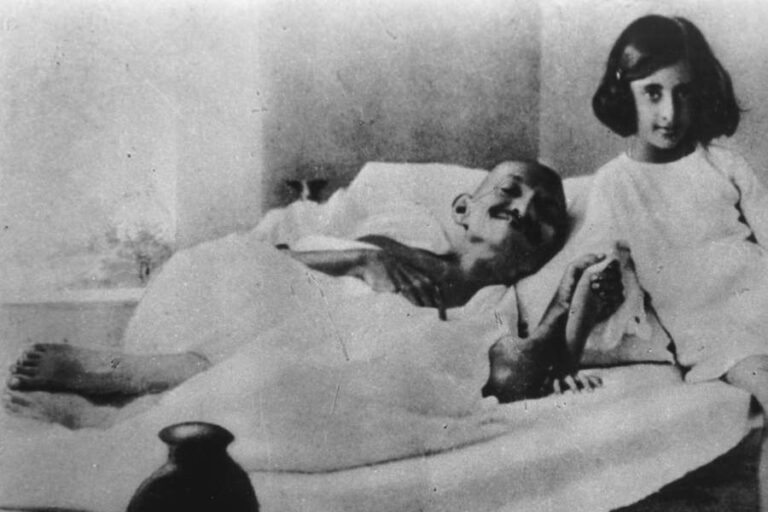Mahatma Gandhi, a prominent figure in India’s struggle for independence, is widely admired for his principles of non-violence, civil disobedience, and his role in achieving freedom from British colonial rule. However, he also had a darker side and faced criticism on various fronts.
The Dark Side of Mahatma Gandhi:
Mahatma Gandhi, born Mohandas Karamchand Gandhi, is one of the most undeniable figure in world history. His commitment to non-violence and civil disobedience played a pivotal role in India’s struggle for independence. However, Gandhi’s legacy is not free from controversies.
Even in present Times, the ideas of Gandhi meets lot of criticism from millions of people around the world.
 Ghana, 2018
Ghana, 2018
In 2018, a Gandhi’s statue was removed from a university campus in Ghana. Activists in Ghana and in Malawi were using the hashtag #GandhiMustFall. They were angry about his early writings. In 1903, when Gandhi was in South Africa, he wrote that white people there should be “the predominating race.” He also said black people “are troublesome, very dirty and live like animals.”
The Gandhi’s Hypocrisy:
Gandhiji addressed a letter to G K Gokhale from Johannesburg on November 22, 1907, in which he expressed that, “we are Indians first and Hindus, Mahomedans, Tamils, Parsees, etc. afterward.”
So according to Gandhi, we are first and foremost Indians then Hindus, Mahomedans, Tamils, Parsees, and so on. The dharma dispatch essay “The Lal Ishtahar and the Bloodbath of Hindus in Bengal” reveals his pro-Muslim and anti-Hindu mindset behind the notion. While he was promoting his “We are Indians First” propaganda, riots broke out in Nohakhali, Moplah, Comilla, Mymensingh, Jamalpur and many parts of India. Those were not only riots, but a Islamic jihad to wipe Hindus out of the world.
Isn’t it true that Gandhi’s “We are Indians First” myth was demolished when Muslims demanded Pakistan and achieved it in 1947.?
Gandhi’s view on Moplah riots:
At the end of the world war I, the Ottoman empire started crumbling, and was finally laid to rest in 1922. But the signs were evident much earlier, and the Khilafat movement started by the Muslims of the subcontinent for the reinstating of the Ottoman Caliphate was given full backing by Congress led by Gandhi. Its amusing to note that Mustafa Kemal Pasha who led the anti caliphate forces is regarded as Ataturk, the founder of modern Turkey. Khilafat then became an anti British movement and then an anti Hindu movement . The cost of every grotesque Hindu Muslim unity by Mohandas Gandhi was to be borne by Hindus alone, with copious amount of blood and dishonour. Anti Hindu riots broke out in all parts of the country, and the most horrifying results were seen in Moplah riots in Malabar, where thousands of Hindus were butchered. Gandhi
didn’t condemn this violence and on the other hand, he called the Moplahs brave and patriotic for doing their duty!
He said, “…..The Moplah revolt is a test for Hindus and Mussulmans. Can Hindus friendship survive the strain put upon it? Can Mussulmans in the deepest recesses of their hearts approve of the conduct of the Moplahs?…….. The Hindus must have the courage and the faith to feel that they can protect their religion in spite of such fanatical eruptions………. “
Hypocrisy for minority appeasement:
Just before the partition, both Hindu and Sikh women were being raped by the Muslims in large numbers. Gandhi advised them that if a Muslim expressed his desire to rape a Hindu or a Sikh lady, she should never refuse him but cooperate with him. She should lie down like a dead with her tongue in between her teeth. Thus the rapist Muslim will be satisfied soon and sooner he leave her.
(D Lapierre and L Collins, Freedom at Midnight, 1997, p-479).
The hypocrisy for minority appeasement to promote Hindu Muslim unity is sickening. The upholding of Hindu Muslim unity meant that Hindu lives didn’t matter. Moplahs were brave and patriotic but there was no word about their victims. He called Abdul Rashid who killed Swami Shraddhanand, as Bhai but didn’t make any effort for Bhagat Singh, Rajguru and Sukhdev. He denied that anything was happening in Noakhali while thousands of Hindus were being butchered there and he went there only when the situation was calmed. After direct action day, he went around preaching communal harmony in Bengal with HS Suhrawardy, the man who was behind it all.
Gandhi’s appeal to Hindus during partition:
” I would tell the Hindus to face death cheerfully if the Muslims are out to kill them. I would be a real sinner if after being stabbed I wished in my last moment that my son should seek revenge. I must die without rancour. … You may turn round and ask whether all Hindus and all Sikhs should die. Yes, I would say. Such martyrdom will not be in vain.”.
 Gandhi with Md Ali Jinnha
Gandhi with Md Ali Jinnha
“Hindus should not harbor anger in their hearts against Muslims even if the latter wanted to destroy them. Even if the Muslims want to kill us all we should face death bravely. If they established their rule after killing Hindus we would be ushering in a new world by sacrificing our lives. None should fear death. Birth and death are inevitable for every human being. Why should we then rejoice or grieve? If we die with a smile we shall enter into a new life, we shall be ushering in a new India.” (Prayer meeting, April 6, 1947, New Delhi, CWMG Vol. 94 page 249)
Gandhi and his followers parroted the distorted sholka of veda “Ahinsa parmo Dharmaha” whereas the entire shloka is “Ahinsa Paramo Dharmaha, Dharmo Hinsa yathev cha” (Non violence is a duty but so is righteous violence).
Anti Hindu quest on the name of unity:
For unity, many distortions had done, such as adding “Ishwar Allah tero naam” into Narsi Mehta’s bhajan Raghupati Raghav Raja Ram, strengthening Muslim League and people like Ali brothers who would be vital in the Pakistan movement.
Promoting Hindustani language ie. (a mixture of Urdu and Hindi) with terms like Badshah Ram and Begum Sita.
Holding Quran reading sessions in temples (but never Geeta reading sessions in mosques).
For unity, Gandhi also forced Hindu refugees to be out of the mosques where they had taken shelter during riots.
Women’s Disrespect:
Gandhi’s commitment to non-violence extended to his personal life, including his experiments with celibacy and abstinence. His vow of celibacy, he use to sleep next to young girls to test his self control.
In his late 70s, before he died at 78, he slept naked with his grandniece when she was in her late teens. He said he wanted to test his willpower to abstain from sex.

The ‘Hunger Strike’ Drama:
Gandhi speeches idea of non violence throughout his life, but Gandhi always use hunger strike, a soft means of violence for letting his voice accepted by the administrations.
Gandhi go on a hunger strike to give those Rs 55 crore to Pakistan, which they did not use for their developmental programs but they used it up against India in 1948 war. The list of Gandhi’s nuisance is endless.
Gandhi is ‘Not’ a father of the nation:
India is an eternal land and its culture is eternal. It is not made by a mandate or a signature hence no person can be called its as father. But what does this society of little men care to think about this. Many people consider MK Gandhi as Father of the nation. So let’s find out wheather it is a truth perception or not.
Mahatma Gandhi was never accorded the ‘Father of the Nation’ title by Government of India and no rule or ordinance was ever passed in this regard. There is no ‘official decoration’. This was stated by the Union cultural ministry in a response to an RTI query filed by UP resident in January 2020.
Writer’s remarks:
Gandhi’s legacy is not pure, but complex one. While he is celebrated for his instrumental role in India’s independence and his philosophy of non-violence, it is essential to recognize the criticisms and controversies that surround him. Gandhi’s life and legacy remind us that every coin has its two sides. Even the most revered figures in history can have flaws and complexities, challenging us to engage in critical discussions about their contributions. The modern youth should know about every side of their history and Gandhi’s views and actions must be understood within the historical context of his time, where societal norms and beliefs differed significantly from modern values.

